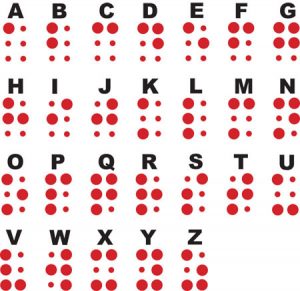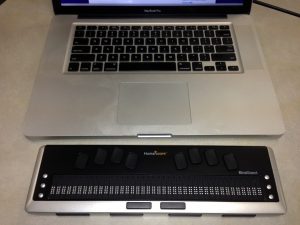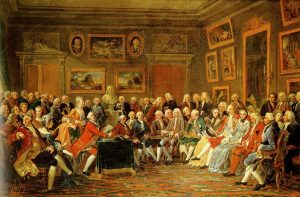Introduction
 For a long time, people with disabilities have not been given the same accessibility and attention, as they should. “The American Disabilities Act of 1990 (ADA) prohibits discrimination and ensures equal opportunity for persons with disabilities in employment, State and local government services, public accommodations, commercial facilities, and transportation” (ADA.gov). My project specifically targets the visibly impaired which in 1996, changed the copyright laws for equal production and distribution of braille text in digital and print forms.
For a long time, people with disabilities have not been given the same accessibility and attention, as they should. “The American Disabilities Act of 1990 (ADA) prohibits discrimination and ensures equal opportunity for persons with disabilities in employment, State and local government services, public accommodations, commercial facilities, and transportation” (ADA.gov). My project specifically targets the visibly impaired which in 1996, changed the copyright laws for equal production and distribution of braille text in digital and print forms.
Copyright laws before the breakthrough weren’t’ favorable for the blind. Anything reproduced for the blind, whether it was a book or an item, was taken one at a time instead of a mass production. The reasoning was because braille text was more expensive and time consuming to produce. Authors and publishers had to and still have to sign off for permission to create a braille text. Many times the process would be delayed for months or eventually, the permission would not go through.
After the law was passed, one of the requirements on copyright permission made way for the future of digital text. “All works which are reproduced or distributed in a specialized format, including Braille, audio, or digital reproductions, must contain a statement that “Further reproduction or distribution in a format other than a specialized format is prohibited.” According to the Library of Congress, this notice must appear both in print (for example, on the label of a recorded disk or cassette) and in the audio, Braille, or digital text itself” (ADA.gov). The steps taken by the U.S government has ensured the future of a universal reading experience.
Purpose
The name of my project is called “The Pressure Annotating System,” it is a physical book that allows the visibly impaired to be able to annotate a text directly in the book and it will have the ability to read that highlighted text back to the user with the braille protruding to indicate the annotated section. I believe that this invention will have a great effect on the visibly impaired community, which can also be used in the classroom.
Audience
As of 2014, an estimated 285 million people globally are visually impaired, and 39 million are blind. About 90 percent of the visually impaired have a low income (World Health Organization, Visual impairment and blindness,). My main audience would be visibly impaired high school and college students. Our job as English students is to be able to read any work critically and closely. What makes this work efficiently is that we are able to see the text in front of us. We can identify the structures and specific diction the author chose to use to create meaning. Around that time, students are beginning to read more text and asked to be able to close read it for a better understanding and to find meaning.
This would also have to extend to teachers who are working with the students on a regular basis. Being able to teach in general is something that has to be constantly worked on, as they have to be someone who can interact well with all students while finding methods and techniques that work. “Johnson characterized learning to teach as “a long-term, complex, developmental process that is the result of participation in the social practices and contexts associated with learning and teaching” (Kristin Davin, Francis Troyan, The Implementation of High-Leverage Teaching Practices).
Technical Specifications
What I want to mix is Text-to-speech technology and pressure sensory. How the book will look and operate is through the pressure applied by the reader. Each page will have to be thicker so that the activation technology can be used on both sides of the page. In the spine, there is a speaker for the text to be spoken. When the reader comes across a word or a phrase that feels important or useful to refer back to, the user simply presses against the braille and it will be said aloud. With the TTS, the page braille on the page will either protrude or change texture to simulate highlighting.
We see text-to-speech used in audiobooks that is accessible to everyone. We see it used in our phones, tablets, kindles, laptops, every piece of established technology. What I really want to develop is the ability to incorporate pressure technology. ”Deep touch pressure refers to a form of tactile sensory input which is often provided by firm holding, firm stroking, cuddling, hugging, and squeezing. Deep touch pressure acts as a calming or focusing agent to increase activity in the parasympathetic division, and lower activity in the sympathetic division of the Autonomic Nervous System (ANS)” (myjacket.com)
Myjacket.com is a website that makes wearable touch technology vests simulates a hugging feeling. They want to improve the quality of life for people dealing with stress, anxiety, and children with autism, ADHD, and other conditions of that nature.
The Pressure Annotating system would work something like this, but flipped. Instead of the pressure against you, the user will be applying pressure. A certain amount of pressure will have to trigger the annotating process. Reading braille now can vary depending on the individual’s finger sensitivity. Health conditions can make it more difficult to read braille. Some books and magazines have incorporated bigger dots to counteract the lack of feeling in the fingers, but it is very limited (Visionaware.org). The text used for the pressure annotating will use softer paper and dots.

A machine called the Refreshable Braille Display is a pad that goes underneath a keyboard so that it can generate braille. The user highlights the line on the computer screen and it turns into text into braille. The pad uses pins to create the dots in each cell. There are eight dots per cell. Six are for braille, and two are to identify the cursor. This technology is similar to what I have envisioned, so I would want to work with the creator to get a better understanding of how this my plan can be achieved and ultimately more beneficial.
Implementation
The target audience may be high school and college scholars, but with high tech hardware, we see today, the students won’t really be the ones to afford it. The Pressure Annotating System will have to be marketed to parents, teachers, and schools, as they are the demographic with the income to afford it. Kevin Carey of The Perkins School for the Blind wrote an article in 2007 on the “Issues of content accessibility in the digital environment” (Kevin Carey, The Opportunities and Challenges of the Digital Age). One of his topics is on the production of print copies of braille text, as it took too long to create which hurt the blind community. “When you think about it, whether you are a student or a voracious reader who likes to discuss new books with friends, a two-year wait for a book is destructively long” (Carey, page 3).
In 2011, Carey promised to cut the price down of the Refreshable Braille Display by 90 percent. He succeeded 5 years later. The device costs $320 to manufacture, and can be bought between $1,300 and $5,000 (Alix Hackett, A low-cost revolution in refreshable braille). With the all the new ways of creating technology now, my design could be something that is quick to manufacture so that users don’t have to wait a long time. It is taking things that have already been created. Incorporating into something new shouldn’t be too difficult.
Email would be a good way of getting attention because of the demographic, and the fact that every person has one. The next big way of marketing this would be through social media and YouTube by hitting relatives and friends of people who are visibly impaired. All it takes is someone with a big enough following to start getting the attention on the product. TV ads could also work because if the individual is old enough, they will probably be more likely to come across it as opposed to the younger generation who doesn’t look at television.
Conclusion
My project idea has a lot of potential to become the next important piece of technology for the visual impaired. The community has come a long way to have equal rights for something that is so important for everyone to know. Being able to read goes towards education, communication, personal growth, and just pure enjoyment. Having all these available outlets now is moving us as a society to becoming more empathetic to all, and hopefully, it will continue to grow with the ability to grasp a complete understanding of a text through The Pressure Annotating System.
Works Cited
Carey, Kevin. “The Opportunities and Challenges of the Digital Age: A Blind User’s Perspective.” Library Trends, vol. 55, no. 4, 2007, pp. 767-784
Davin, Kristin J. and Francis J. Troyan. “The Implementation of High-Leverage Teaching Practices: From the University Classroom to the Field Site.” Foreign Language Annals, vol. 48, no. 1, 2015, pp. 124-142.
Hackett, Alix. “A low-cost revolution in refreshable braille.” Perkins School for the Blind, March 24, 2014, Accessed 5/5/17
“All About Braille”, Visionaware.com, accessed 5/2/17
“New Copyright Law Breakthrough For The Blind” Future Reflections: The National Federation of the Blind Magazine for Parents and Teachers of Blind Children, Vol.16, No.1 1997. Accessed 5/5/17
“Refreshable Braille Displays” American Foundation For the Blind, Accessed 5/5/17
“The Americans with Disabilities Act of 1990 and Revised ADA Regulations
Implementing Title II and Title III” ADA.gov, Accessed 5/5/17
“The Science Behind Tjacket”, mytjacket.com, accessed 5/2/17
“Visual impairment and blindness”, World Health Organization, Who.int, August 2014, Accessed 5/5/17
Photos and Videos
Williams, George. “Refreshable Braille Display” Flickr March 8, 2013, Accessed 5/5/17
“Braille Alphabet”, Wikimedia Commons, Accessed 5/5/17
HumanWareTechnologie “HumanWare Brailliant Braille Display” YouTube May 15, 2012, Accessed 5/5/17

 ic of Letters can sometimes be called the men of letters because society refrained women from participating. That did not mean however, that there were not many important women figures who were a part in the age. Salons played a pivotal role in not only bringing together intelligent individuals to educate one another, but they established order and a civil space. One salon owner was Marie-Therese Geoffrin. Her establishment became well known and most frequented as she held weekly dinners from 1749 until her death in 1777. She had inherited the salon from Madame de Tencin, who was more unconventional compared to Geoffrin who wasn’t formally educated, but had natural intelligence. Marie-Therese Geoffrin strict rule during her occasions was no talk of politics or religion. The host and hostesses of the salons were very respected among the “Men Of Letters”, it didn’t also allowed for their reputation to grow if they received enough praise (“The Kingdom of Politesse”).
ic of Letters can sometimes be called the men of letters because society refrained women from participating. That did not mean however, that there were not many important women figures who were a part in the age. Salons played a pivotal role in not only bringing together intelligent individuals to educate one another, but they established order and a civil space. One salon owner was Marie-Therese Geoffrin. Her establishment became well known and most frequented as she held weekly dinners from 1749 until her death in 1777. She had inherited the salon from Madame de Tencin, who was more unconventional compared to Geoffrin who wasn’t formally educated, but had natural intelligence. Marie-Therese Geoffrin strict rule during her occasions was no talk of politics or religion. The host and hostesses of the salons were very respected among the “Men Of Letters”, it didn’t also allowed for their reputation to grow if they received enough praise (“The Kingdom of Politesse”).
